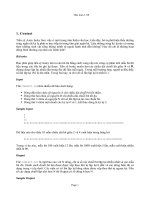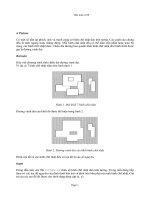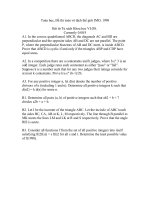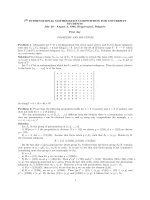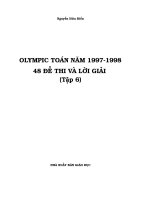C1250 93(reapproved 1998)
Bạn đang xem bản rút gọn của tài liệu. Xem và tải ngay bản đầy đủ của tài liệu tại đây (11.08 KB, 2 trang )
Designation: C 1250 – 93 (Reapproved 1998)
Standard Test Method for
Nonvolatile Content of Cold Liquid-Applied Elastomeric
Waterproofing Membranes1
This standard is issued under the fixed designation C 1250; the number immediately following the designation indicates the year of
original adoption or, in the case of revision, the year of last revision. A number in parentheses indicates the year of last reapproval. A
superscript epsilon (e) indicates an editorial change since the last revision or reapproval.
7. Conditioning/Mixing
7.1 Unless otherwise specified by those authorizing the
tests, standard conditions for all tests are 23 6 2°C (73.4 6
3.6°F) and 50 6 5 % relative humidity.
7.2 Store all membrane materials to be tested in an unopened container at standard conditions for at least 24 h before
any test specimens are prepared.
7.3 Follow the manufacturer’s instructions for mixing and
preparing membrane materials for testing. Thoroughly mix
one-component materials before using. Mix two-component
compounds in the ratio recommended by the manufacturer.
1. Scope
1.1 This test method describes a laboratory procedure for
determining the average nonvolatile content for one- or twocomponent cold liquid-applied elastomeric waterproofing
membranes.
1.2 The values stated in SI units are to be regarded as the
standard. The values in parentheses are for information only.
1.3 This standard does not purport to address all of the
safety concerns, if any, associated with its use. It is the
responsibility of the user of this standard to establish appropriate safety and health practices and determine the applicability of regulatory limitations prior to use.
8. Procedure
8.1 For each test sample, prepare two test specimens as
follows:
8.1.1 Mark each aluminum weighing dish for identification.
Accurately weigh each aluminum weighing dish to the nearest
0.01 g. Record each mass.
8.1.2 Place an aluminum weighing dish on the balance and
tare. Add 5.06 0.2 g of compound and spread evenly over the
interior surface area of the dish.
8.1.3 Reweigh the test specimen, combination membrane,
and dish, and record the mass.
8.1.4 Repeat 8.1.2 and 8.1.3 for duplicate specimens.
8.1.5 Immediately place the dishes in a forced-draft oven for
72 h at 70 6 2°C (158 6 3.6°F).
8.1.6 Remove the specimens and allow them to cool at
standard conditions for 30 min. Weigh the specimens and
calculate the percent nonvolatile as follows:
2. Referenced Documents
2.1 ASTM Standards:
C 717 Terminology of Building Seals and Sealants2
3. Terminology
3.1 Definitions—Refer to Terminology C 717 for definitions
of compound, elastomeric, and waterproofing, used in this test
method.
4. Summary of Test Method
4.1 This test method consists of preparing duplicate
samples, each of known mass, and aging these samples for 72
h at 70 6 2°C (158 6 3.6°F) in an air-circulating oven.
5. Significance and Use
5.1 This test method is used to determine the nonvolatile
content of cold liquid-applied elastomeric waterproofing membranes and can be useful in determining application coverage
rates.
nonvolatile, % 5 @~W3 2 W 1!/~W2 2 W1!# 3 100
(1)
where:
W1 5 mass of aluminum weighing dish,
W2 5 mass of aluminum dish with fresh compound, and
W 3 5 mass of heat-aged dish and compound.
6. Apparatus
6.1 Forced-draft Oven, controlled to 70 6 2°C (158 6
3.6°F).
6.2 Balance, sensitive to 0.01 g.
6.3 Two Aluminum Weighing Dishes, 57 by 18 mm.
Volatile Content, % 5 100 2 ~nonvolatile!
(2)
9. Report
9.1 Report the following information for each sample
tested.
9.1.1 Identification of the compound tested,
9.1.2 Description of compound type, and
9.1.3 Nonvolatile content determined.
1
This test method is under the jurisdiction of ASTM Committee C-24 on
Building Seals and Sealants and is the direct responsibility of Subcommittee C24.80
on Building Deck Waterproofing Systems.
Current edition approved Sept. 15, 1993. Published December 1993.
2
Annual Book of ASTM Standards, Vol 04.07.
Copyright © ASTM, 100 Barr Harbor Drive, West Conshohocken, PA 19428-2959, United States.
1
C 1250
10. Precision and Bias
11. Keywords
10.1 Round-robin testing is in process.
11.1 membrane; nonvolatile; waterproofing
The American Society for Testing and Materials takes no position respecting the validity of any patent rights asserted in connection
with any item mentioned in this standard. Users of this standard are expressly advised that determination of the validity of any such
patent rights, and the risk of infringement of such rights, are entirely their own responsibility.
This standard is subject to revision at any time by the responsible technical committee and must be reviewed every five years and
if not revised, either reapproved or withdrawn. Your comments are invited either for revision of this standard or for additional standards
and should be addressed to ASTM Headquarters. Your comments will receive careful consideration at a meeting of the responsible
technical committee, which you may attend. If you feel that your comments have not received a fair hearing you should make your
views known to the ASTM Committee on Standards, at the address shown below.
This standard is copyrighted by ASTM, 100 Barr Harbor Drive, PO Box C700, West Conshohocken, PA 19428-2959, United States.
Individual reprints (single or multiple copies) of this standard may be obtained by contacting ASTM at the above address or at
610-832-9585 (phone), 610-832-9555 (fax), or (e-mail); or through the ASTM website (www.astm.org).
2
